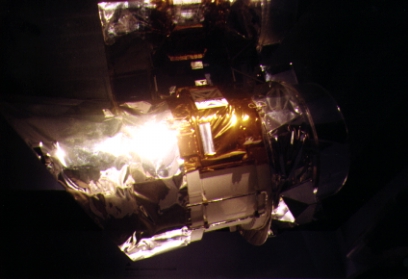
|
This engineering mockup of IRAS was photographed at the National Air and Space Museum, in Washington, D.C. The fixed solar array is at the top, and the angled sunshade to the left. |

|
This engineering mockup of IRAS was photographed at the National Air and Space Museum, in Washington, D.C. The fixed solar array is at the top, and the angled sunshade to the left. |
Astronomy in the far-infrared came of age with the highly successful IRAS mission in 1983/4 (intending nothing less than admiration for the folks who did amazing things from aircraft or balloons before that). The joint US/UK/Dutch mission incorporated a 60-cm telescope, the whole thing cocooned in a liquid helium tank to keep the instrument's own thermal radiation from swamping the signal from the sky. I actually saw this one go into orbit while standing in front of my apartment in Tucson, from before the strapon boosters fell away right past second stage ignition. I pointed this out to several uninterested passersby, and got the look that I've come to know so well. IRAS was inserted into a sun-synchronous polar (actually slightly retrograde) orbit which kept it in continuous sunlight, and for its major survey mission it could be kept constantly pointing directly away from the Earth. As it scanned the sky, sources swept over an array of detectors from 12-100 microns in wavelength, gradually building up a nearly complete sky survey. Before launch, team members confidently predicted that several thousand sources would be detected. So far, it's closer to one million, depending on how you process the data. IRAS really put starburst galaxies on the astronomical radar screen, though the phenomenon had been identified from earlier infrared and optical studies, showed us solid debris clouds around nearby stars, and traced the interstellar dust in our own galaxy at unprecedented (indeed sometimes annoying) sensitivity.
The IRAS source catalogs were made public quickly after the mission, marking a new sociological experiment in the astronomical community. Suddenly one needed not be a cryogenic engineer to do IR astronomy, and furthermore everyone had equal access to data or the same quality. With no working instrument once the helium ran out, no one could get any better data than anyone else. In a sense, it was a dry run for how the community could handle the HST or ROSAT archives later. Lots of us pounced on initial galaxy projects, so I'll highlight a few of these.
Several of us at Leiden dug into the pointed observations, searching for serendipitous detections of active galactic nuclei. Initial work by Miley and crew had shown that far-IR colors were a very good way of picking (some) AGN out of a huge number of normal galaxies in the IRAS catalogs. We co-added multiple pointings of about one thousand small fields, deeper than the survey data, and found over 100 new AGN candidates (followed up optically from assorted locations). We detected some Seyfert nuclei and QSOs as distant at z=0.53. Bryan Irby has finished the reduction of the spectra, and a full report should be published any year now.
IRAS data have also been important in exploring how environment affects star formation in galaxies, in particular how interactions and mergers can drive up the amount of star formation. With Jack Gallimore at Alabama, we examined the pairing statistics of galaxies detected by IRAS, finding (surprise!) a pronounced excess of neighbors for IR-brighter (and more rapidly star-forming) systems. More recently, I used detailed analysis of the scan profiles of galaxy pairs to estimate their individual far-IR intensities, knowing the positions of the galaxies from optical work, thus allowing a stretch of the limited resolution of IRAS.
Last changes: 4/2000 © 2000